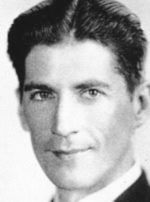We've had a discussion of dirigibles for the last couple weeks and learned that many of them crashed between 1930 and 1937. So, why was the Hindenburg disaster so important to history?
Part of its significance was the insignia on the tail fin of the airship - the Swastika. The Zeppelin Company from Germany built it and placed this German symbol on the fins.
During the 30s, Hitler's power was growing. He wanted to show that Germany was superior to other countries in the world. By having the Zeppelins successfully fly important people around the world when other countries failed to fly these long distances, he was proving that Germany surpassed everyone else.
When it crashed in May, 1937, the news reverberated around the world. It was a defeat for Germany - at least for Hitler's boasting.
 |
| Herbert Morrison |
The other reason this disaster was so well-known is the media coverage that memorialized it. WLS radio from Chicago wanted to share this historic event - the landing of the Hindenburg - with their Chicago audience. Of course, they planned to record it not knowing what the day would bring. Back in those days, they didn't have the equipment to do a live broadcast, so they sent an announcer - Herbert Morrison - and his engineer - Charlie Nehlsen - to make a recording of the event at the naval station. The thought was to get on an airplane and get back to Chicago to play the broadcast the next day.
Morrison and Nehlsen had their recording equipment set up and ready when the airship came in sight. Morrison started recording his voice description of the event as he usually would. When he saw flames coming out of the tail, he described what happened with his hysterical comments included. As a result, there is a voice recording of the events as they unfolded before his eyes.
At the same time, other news sources were recording the event of the landing on newsreels. The footage of the airship bursting into flames and crashing to the ground was very dramatic, to say the least. At a later time, Morrison's voice was linked with the newsreel's video footage to make it more dramatic. Click on this link to see and hear a short portion of the recording: https://www.youtube.com/watch?v=0Ad9tholMEM
The drama is palpable when one sees the event and hears Morrison's emotional commentary. This video, with a different narration, was shared in the movie theaters across the world, bringing the end of the Zeppelins for commercial flights. No one wanted to pay to fly on something this unsafe.
Morrison's voice recording was indeed flown back to Chicago and broadcast to the Chicago radio audience later that night. NBC Radio played portions of it across the country bringing this important event to the awareness of millions of Americans. It was the first time a recording of a news event was ever broadcast from coast-to-coast.
This event is now considered a classic in audio history and is the most well-known event involving a dirigible to this day. Our 24/7 news coverage we have today had its beginning in 1937 with this on-the-scene description that Morrison happened to witness on that fateful day. After this exciting news coverage, the American audience wanted to hear live coverage for other events, including WWII.
Information taken from Wikipedia Herbert Morrison (announcer) and Wikipedia Hindenburg disaster


No comments:
Post a Comment